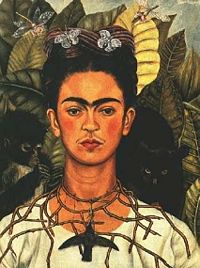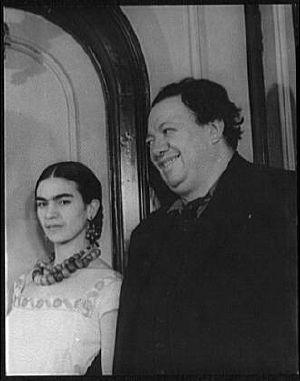Encyclopedia, Difference between revisions of "Frida Kahlo" - New World
Mary Anglin (talk | contribs) m |
Mary Anglin (talk | contribs) |
||
| Line 8: | Line 8: | ||
During her life, Kahlo was recognized primarily by the intellectual elite, both in Mexico and internationally, but was not well known among ordinary Mexicans, particularly because she worked in mediums that did not lend themselves to mass distribution. [http://mati.eas.asu.edu:8421/ChicanArte/html_pages/KahloIssOutl.html#artmaker] | During her life, Kahlo was recognized primarily by the intellectual elite, both in Mexico and internationally, but was not well known among ordinary Mexicans, particularly because she worked in mediums that did not lend themselves to mass distribution. [http://mati.eas.asu.edu:8421/ChicanArte/html_pages/KahloIssOutl.html#artmaker] | ||
| − | A child during the Mexican Revolution, Kahlo grew up in an era of social change. In the 1920s Frida espoused a Communist, anti-capitalist, philosophy, | + | A child during the Mexican Revolution, Kahlo grew up in an era of social change. In the 1920s Frida espoused a Communist, anti-capitalist, philosophy, She befriended the famed Bolshevik revolutionary and Marxist theorist, [[Leon Trostky]], who was assassinated in her home country of Mexico. |
| − | Known for her unconventional appearance and flamboyantly styled clothing, Ms. Kahlo accomplished much in her short tragic life. She was a surrealist artist who expressed her inner self through her paintings. To the public she was a high spirited rebellious woman. Her creative style was breathtaking yet bewildering. Frida was probably the most idolized woman artist of her time | + | Known for her unconventional appearance and flamboyantly styled clothing, Ms. Kahlo accomplished much in her short tragic life. She was a surrealist artist who expressed her inner self through her paintings. To the public she was a high spirited rebellious woman. Her creative style was breathtaking yet bewildering. Frida was probably the most idolized woman artist of her time. Today, she is a figure of legendary power whose work inspires excitement and awe throughout the world. [http://www.jlhs.nhusd.k12.ca.us/classes/social_science/Latin_America/Frida%20Kahlo/Frida_Kahlo.html] |
==Family and Childhood== | ==Family and Childhood== | ||
| Line 21: | Line 21: | ||
| − | == | + | ==The Artist== |
[[Image:Frida Kahlo Diego Rivera 1932.jpg|thumb|right|Frida Kahlo with [[Diego Rivera]] in 1932]] | [[Image:Frida Kahlo Diego Rivera 1932.jpg|thumb|right|Frida Kahlo with [[Diego Rivera]] in 1932]] | ||
| Line 28: | Line 28: | ||
Although Kahlo's work is sometimes classified as [[surrealist]], and she did exhibit several times with [[Europe]]an surrealists, she never considered herself a surrealist. "I paint my own reality," she once said. Her preoccupation with [[female]] themes and the figurative candor with which she expressed them made her something of a [[feminist]] cult figure in the last decades of the [[20th century]]. | Although Kahlo's work is sometimes classified as [[surrealist]], and she did exhibit several times with [[Europe]]an surrealists, she never considered herself a surrealist. "I paint my own reality," she once said. Her preoccupation with [[female]] themes and the figurative candor with which she expressed them made her something of a [[feminist]] cult figure in the last decades of the [[20th century]]. | ||
| − | + | ==Marriage and Personal Life== | |
Despite her life of suffering and pain, Frida Kahlo was a vibrant, extroverted character whose everyday speech was filled with [[Profanity|profanities]]. She had been a [[tomboy]] in her youth and carried her fervor throughout her life. She was a heavy smoker, drank [[liquor]] (especially tequila) in excess, was openly bisexual, sang off-color songs, and told equally [[ribald]] jokes to the guests of the wild parties that she hosted. | Despite her life of suffering and pain, Frida Kahlo was a vibrant, extroverted character whose everyday speech was filled with [[Profanity|profanities]]. She had been a [[tomboy]] in her youth and carried her fervor throughout her life. She was a heavy smoker, drank [[liquor]] (especially tequila) in excess, was openly bisexual, sang off-color songs, and told equally [[ribald]] jokes to the guests of the wild parties that she hosted. | ||
Revision as of 20:14, 15 August 2006
Frida Kahlo, born Magdalena Carmen Frida Kahlo y Calderón de Rivera (July 6, 1907 to July 13, 1954), was a Mexican painter of the indigenous culture of her country in a style combining Realism, Symbolism and Surrealism. She was the wife of the Mexican muralist and cubist painter Diego Rivera.
Kahlo's life was one marked by suffering, heroism, and genius. Stricken with polio as a child, then nearly crippled in a bus accident at the age of eighteen, Kahlo defied the odds, not only by learning to walk again, but by taking the world by storm with her unique artistic vision.[1]
During her life, Kahlo was recognized primarily by the intellectual elite, both in Mexico and internationally, but was not well known among ordinary Mexicans, particularly because she worked in mediums that did not lend themselves to mass distribution. [2]
A child during the Mexican Revolution, Kahlo grew up in an era of social change. In the 1920s Frida espoused a Communist, anti-capitalist, philosophy, She befriended the famed Bolshevik revolutionary and Marxist theorist, Leon Trostky, who was assassinated in her home country of Mexico.
Known for her unconventional appearance and flamboyantly styled clothing, Ms. Kahlo accomplished much in her short tragic life. She was a surrealist artist who expressed her inner self through her paintings. To the public she was a high spirited rebellious woman. Her creative style was breathtaking yet bewildering. Frida was probably the most idolized woman artist of her time. Today, she is a figure of legendary power whose work inspires excitement and awe throughout the world. [3]
Family and Childhood
Kahlo was born Magdalena Carmen Frieda Kahlo y Calderón in her parents' house in Coyoacán, which at the time was a small town on the outskirts of Mexico City. The young Frida suffered a bout of polio at age six, which left her right leg looking much thinner than the other. Still, with her father's encouragement and with the feisty and brash personality that she kept throughout her life, she overcame her disability.
Frida Kahlo's full name was Magdalena Carmen Frida Kahlo y Calderón de Rivera. She was born in Coyoacán, Mexico on July 6, 1907. She later changed her birth year to 1910 in order to affiliate herself further with being a product of the Mexican Revolution, which began in 1910. Her father, a Hungarian Jew, immigrated from Germany to Mexico and married a Mexican woman of both Native and Spanish descent. [4]
In 1925, a trolley car collided with a bus in which Kahlo was riding; she suffered a broken spinal column, a broken collarbone, broken ribs, a broken pelvis, 11 fractures in her right leg, a crushed and dislocated right foot, and a dislocated shoulder. She survived her injuries and eventually regained her ability to walk, but she would have relapses of extreme pain which would plague her for life, often leaving her hospitalized and/or in bed for months at a time, agonized and miserable. Frida would undergo as many as thirty-five operations in her life as a result of the accident, mainly on her back and her right leg/foot.
The Artist
After the accident, Kahlo turned her attention from a medical career to a full-time painting career. Drawing on her personal experiences (her troubled marriage, her painful miscarriages, her numerous operations), her works are often shocking in their stark portrayal of pain. Fifty-five of her 143 paintings are self-portraits, often incorporating symbolic portrayal of her physical and psychological wounds. She was deeply influenced by indigenous Mexican culture, which surfaced in her paintings' bright colors, dramatic symbolism, and unapologetic rendering of often harsh and gory content.
Although Kahlo's work is sometimes classified as surrealist, and she did exhibit several times with European surrealists, she never considered herself a surrealist. "I paint my own reality," she once said. Her preoccupation with female themes and the figurative candor with which she expressed them made her something of a feminist cult figure in the last decades of the 20th century.
Marriage and Personal Life
Despite her life of suffering and pain, Frida Kahlo was a vibrant, extroverted character whose everyday speech was filled with profanities. She had been a tomboy in her youth and carried her fervor throughout her life. She was a heavy smoker, drank liquor (especially tequila) in excess, was openly bisexual, sang off-color songs, and told equally ribald jokes to the guests of the wild parties that she hosted.
External links
Frida Kahlo
- The Life and Art of Frida Kahlo
- "The Frida Kahlo Museum", by Gale Randall
- Exhibition guide from Tate Modern
- Frida's House Yahoo! group
- "Frida Kahlo & contemporary thought"
- "Frida by Kahlo"
- "Frida Kahlo" at ArtCyclopedia
- Frida (2002 film) at the Internet Movie Database
- (Spanish) "Dolor y arte: Frida Kahlo" from Psikeba Magazine
- Ten Dreams Galleries
- Photos
Credits
New World Encyclopedia writers and editors rewrote and completed the Wikipedia article in accordance with New World Encyclopedia standards. This article abides by terms of the Creative Commons CC-by-sa 3.0 License (CC-by-sa), which may be used and disseminated with proper attribution. Credit is due under the terms of this license that can reference both the New World Encyclopedia contributors and the selfless volunteer contributors of the Wikimedia Foundation. To cite this article click here for a list of acceptable citing formats.The history of earlier contributions by wikipedians is accessible to researchers here:
The history of this article since it was imported to New World Encyclopedia:
Note: Some restrictions may apply to use of individual images which are separately licensed.


